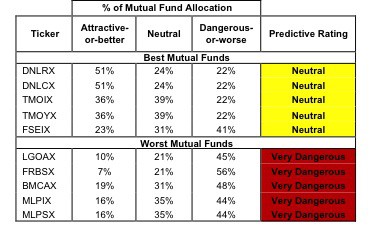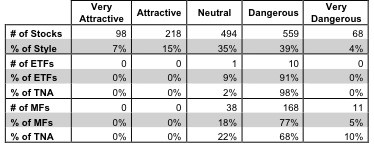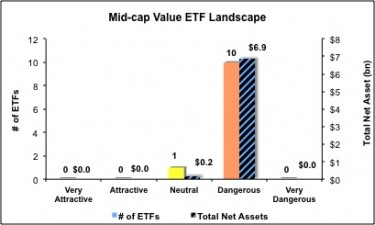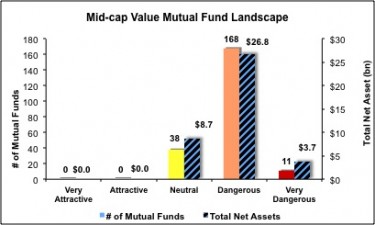The mid-cap value style ranks eleventh out of the twelve fund styles as detailed in my style roadmap. It gets my Dangerous rating, which is based on aggregation of ratings of 11 ETFs and 217 mutual funds in the mid-cap value style as of May 2, 2012. Reports on the best & worst ETFs and mutual funds in every sector and style are on my blog.
Figure 1 ranks from best to worst the nine mid-cap value ETFs that meet our liquidity standards and Figure 2 shows the five best and worst-rated mid-cap value mutual funds. The best ETFs and mutual funds allocate more value to Attractive-or-better-rated stocks than the worst, which allocate too much value to Neutral-or-worse-rated stocks.
To identify the best and avoid the worst ETFs and mutual funds within the mid-cap value style, investors need a predictive rating based on (1) stocks ratings of the holdings and (2) the all-in expenses of each ETF and mutual fund. Investors need not rely on backward-looking ratings. My fund rating methodology is detailed here.
Investors should not buy any mid-cap value ETFs or mutual funds because none get an Attractive-or-better rating. If you must have exposure to this style, you should buy a basket of Attractive-or-better rated stocks and avoid paying undeserved fund fees. Active management has a long history of not paying off.
Figure 1: ETFs with the Best & Worst Ratings – Top 5 (where available)
* Best ETFs exclude ETFs with less NAV’s less than 100 million.
Sources: New Constructs, LLC and company filings
iShares Russell Mid Value Index Fund [s: JKI] and First Trust Mid Cap Value AlphaDEX Fund [s: FNK] are excluded from Figure 1 because their total net assets (TNA) are below $100 million and do not meet our liquidity standards.
Figure 2: Mutual Funds with the Best & Worst Ratings – Top 5
* Best mutual funds exclude funds with NAV’s less than 100 million.
Sources: New Constructs, LLC and company filings
WisdomTree MidCap Earnings Fund [s: EZM] is my top-rated mid-cap value ETF and Strategic Funds, Inc: Dreyfus Active MidCap Fund [s: DNLRX] is my top-rated mid-cap value mutual fund. Both earn my Neutral rating and although they are the best-rated, should not be purchased.
SPDR S&P 400 Mid Cap Value ETF [s: MDYV] is my worst-rated mid-cap value ETF and ProFunds: Mid-Cap Value ProFund [s: MLPSX] is my worst-rated mid-cap value mutual fund. Both earn a Dangerous-or-worse rating and should be avoided.
Figure 3 shows that only 316 out of the 1437 stocks (less than 22% of the total net assets) held by mid-cap value ETFs and mutual funds get an Attractive-or-better rating. Given the low allocation to Attractive stocks, its not surprising that none of the 11 ETFs or 217 mutual funds are worth buying.
The takeaways are: mutual fund managers allocate too much capital to low-quality stocks and mid-cap value ETFs hold poor quality stocks.
Figure 3: Mid-cap Value Style Landscape For ETFs, Mutual Funds & Stocks
Sources: New Constructs, LLC and company filings
As detailed in “Cheap Funds Dupe Investors”, the fund industry offers many cheap funds but very few funds with high-quality stocks, or with what I call good portfolio management.
Investors should not buy any mid-cap value ETFs or mutual funds, as ten of the 11 ETFs and 179 of the 217 earn a Dangerous-or-worse rating and should be sold and avoided. Investors should focus on individual stocks over mid-cap value ETFs and mutual funds. See my Stock Screener to find Attractive stock investments.
Coca-Cola Enterprises, Inc [s: CCE] is one of my favorite stocks held by mid-cap value ETFs and mutual funds and earns my Very Attractive rating. CCE offers investors a lot of upside. Since the spinoff from The Coca-Cola Company [s: KO] in late 2010, the company has generated double-digit returns on invested capital (ROIC) each year. During 2011, CCE realized a 19% increase in after-tax cash flows (NOPAT), which gets me excited considering that CCE’s valuation (~$29.89) implies that after-tax cash flows will decrease by 10% and stay there forever. I expect CCE to outperform the market’s low expectations, which will lead to price appreciation for stockholders.
Ashland Inc. [s: ASH] is one of my least favorite stocks held by mid-cap value ETFs and mutual funds and earns my Very Dangerous rating. ASH earns a disappointing ROIC of 1%, which places it in the 22nd percentile of all Russell 3000 companies. Despite poor historical cash flows, ASH’s current valuation implies considerable cash flow growth. To justify its current stock price (~$66.39) ASH must increase its after-tax cash flows (NOPAT) by 13% compounded annually for 22 years. It is tough to want to bet that ASH will achieve this kind of growth given that its average NOPAT growth over the past 7 years has been -2%.
Figures 4 and 5 show the rating landscape of all mid-cap value ETFs and mutual funds.
My style roadmap report ranks all styles and highlights those that offer the best investments.
Figure 4: Separating the Best ETFs From the Worst Funds
Figure 5: Separating the Best Mutual Funds From the Worst Funds
Review my full list of ratings and rankings along with free reports on all 11 ETFs and 217 mutual funds in the mid-cap value style.
Disclosure: I receive no compensation to write about any specific stock, sector, style or theme.





